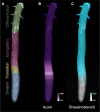Cytoplasmic Linker Protein-Associating Protein at the Nexus of Hormone Signaling, Microtubule Organization, and the Transition From Division to Differentiation in Primary Roots
- PMID: 35574108
- PMCID: PMC9096829
- DOI: 10.3389/fpls.2022.883363
Cytoplasmic Linker Protein-Associating Protein at the Nexus of Hormone Signaling, Microtubule Organization, and the Transition From Division to Differentiation in Primary Roots
Abstract
The transition from cell division to differentiation in primary roots is dependent on precise gradients of phytohormones, including auxin, cytokinins and brassinosteroids. The reorganization of microtubules also plays a key role in determining whether a cell will enter another round of mitosis or begin to rapidly elongate as the first step in terminal differentiation. In the last few years, progress has been made to establish connections between signaling pathways at distinct locations within the root. This review focuses on the different factors that influence whether a root cell remains in the division zone or transitions to elongation and differentiation using Arabidopsis thaliana as a model system. We highlight the role of the microtubule-associated protein CLASP as an intermediary between sustaining hormone signaling and controlling microtubule organization. We discuss new, innovative tools and methods, such as hormone sensors and computer modeling, that are allowing researchers to more accurately visualize the belowground growth dynamics of plants.
Keywords: Arabidopis thaliana; CLIP-associating protein (CLASP); PIN2; auxin; brassinosteroid (BR) signaling; cytokinin (CK); root apical meristem; sorting nexin 1 (SNX1).
Copyright © 2022 Halat, Bali and Wasteneys.
Conflict of interest statement
The authors declare that the research was conducted in the absence of any commercial or financial relationships that could be construed as a potential conflict of interest.
Figures



References
Publication types
LinkOut - more resources
Full Text Sources
Other Literature Sources
Molecular Biology Databases
Research Materials

